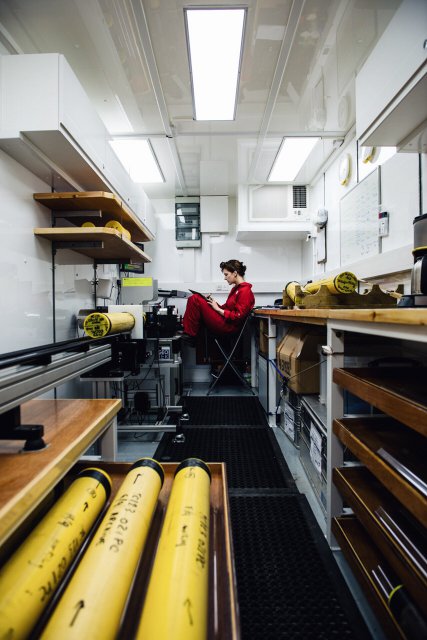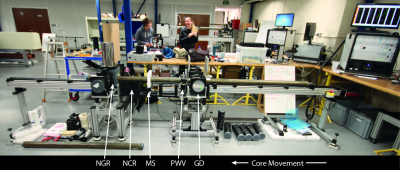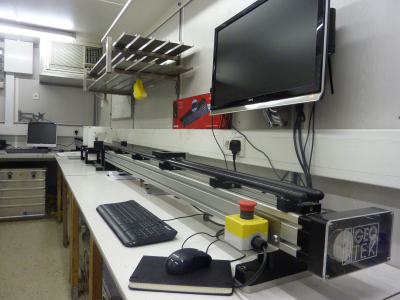Physical Properties
Multi Sensor Core Logger (MSCL)
Exp. 302 Arctic coring Expedition
Exp. 310 Tahiti Sea-level
Exp. 313: New Jersey Shallow Shelf
Exp. 325: Great Barrier Reef Environmental Changes
Exp. 347: Baltic Sea Paleoenvironment
Procedures for operating the MSCL are provided and discussed with scientists who will use the equipment prior to the Offshore phase of each Expedition. Full details on MSCL setup, calibration, operating and processing procedures can be found in the Geotek MSCL manual.
Gamma density is measured by determining the attenuation of gamma rays (mainly by Compton scattering) that pass through the cores, and is used to estimate bulk density. The degree of attenuation is proportional to the electron density in the gamma path. Gamma attenuation coefficients vary as a function of atomic number, but, as most earth-forming minerals have similar and low atomic numbers, the correlation between gamma density and bulk density is generally very good. A small (370 MBq) 137Cs source (half-life 30.2 yrs) is used to produce a gamma beam with primary photon energies of 662 keV. Two collimators are available of 2.5 mm and 5 mm. The maximum measurement resolution obtainable by the sensor is 0.5 cm (using the 2.5 mm collimator) and the minimum integration time for a statistically significant measurement is 1 s. Calibration of the system is completed using known water/aluminum density standards.
Transverse P-wave velocity is measured using two P-wave transducers aligned perpendicular to the core axis with P-waves passing through the core horizontally (in whole-core set up). A compressional wave pulse centred on a frequency of 230 kHz is transmitted through the core. A pair of displacement transducers monitors the separation between the P-wave transducers so that variations in the outside diameter of the liner do not degrade the accuracy of the measured velocities. This measurement is critically affected by the quality of the core, such that undersized core where the core is not directly in contact with the liner will reduce the measurement quality. Initial calibration is performed using distilled water at known temperature.
Electrical resistivity of sediment cores is measured using the non-contact resistivity sensor. The sensor operates by inducing a high frequency magnetic field in the core, which in turn induces electrical currents in the core. The small magnetic fields regenerated by this electrical current are measured on a receiver coil and normalized with a third set of identical coils operating in air. The spatial resolution of measurement is approximately 2-4 cm. Initial calibration is performed using five standard core liner sections containing water of varying, but known, salinity.
Magnetic susceptibility (MS)
Whole-core magnetic susceptibility is measured on the MSCL using a Bartington MS2 meter coupled to a MS2C sensor coil. The loop sensor has an internal diameter of 80 mm corresponding to a coil diameter of 88 mm, however other loop sizes are available to optimize with core size. It normally operates at a frequency of 565 Hz, but frequencies may be offset if required. The MS2 system operates on two fixed sensitivity levels- x0.1 and x1- corresponding to a 10 and 1 second sampling integration period respectively. The sensor automatically zeroes and takes a free air reading at the start and end of each run in order to account for instrument drift (by subtraction of a linear interpolation between these two readings). The accuracy of the magnetic susceptibility sensor is checked using a calibration standard with a bulk susceptibility of 213 x 10-6 cgs.
Spectral natural gamma radiation is measured through the use of three 3” x 3” NaI(Tl) scintillator crystals housed in 6” diameter lead shields. These three detectors are optically coupled to a photomultiplier tube and connected to an integrated bias base and Target/ICx scintiSpec MCA. The detectors are oriented at 90 degrees to one another, converging inside a large lead cube through which the core passes. Alternate diameter nylon inserts can be used to account for different core diameters. Multiple sensors and the lead cube are used to simultaneously increase detection and reduce background; thus decreasing the necessary count time such that the apparatus can be efficiently added to the existing MSCL-S track. Calibration is achieved by attributing detectable energies in the range of 0-3000 keV to 1024 channels. Specific channels can then be related to the elemental yields of K, U and Th. Processing of the data is achieved by removing a background value from the data. Background is measured over a 12+ hour period prior to the expedition but in the same environment. Spatial resolution is controlled by the scintillator crystal size (around 3”).

Sally Morgan working in the petrophysics container. photo: A. Ingle @ ECORD/IODP




